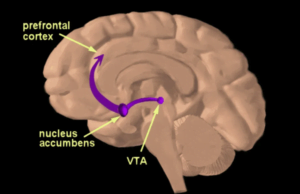Reward System
 To understand why we are driven by tasty food, loving touch, sexual desire, alcohol, heroin, pornography, chocolate, gambling, social media or online shopping, we need to know about the reward system.
To understand why we are driven by tasty food, loving touch, sexual desire, alcohol, heroin, pornography, chocolate, gambling, social media or online shopping, we need to know about the reward system.
The reward system is one of the most important systems in the brain. It drives our behaviour towards pleasurable stimuli such as food, sex, alcohol, etc. And it drives us away from painful ones that require more energy or effort such as conflict, homework, etc. See this short video on the role of the amygdala, our internal alarm system.
The reward system is where we feel emotions and process those emotions to start or stop action. It consists of a group of brain structures at the core of the brain. They weigh up whether or not to repeat a behaviour and form a habit. A reward is a stimulus that drives an appetite to alter behaviour. Rewards typically serve as reinforcers. That is, they make us repeat behaviours that we perceive (unconsciously) as good for our survival, even when they’re not. Pleasure is a better reward or stimulus than pain for motivating behaviour. A carrot is better than a stick etc.
The Striatum
At the centre of the reward system is the striatum. It is the region of the brain that produces feelings of reward or pleasure. Functionally, the striatum coordinates the multiple aspects of thinking that help us make a decision. These include movement and action planning, motivation, reinforcement, and reward perception. It’s where the brain weighs up the value of a stimulus in a nanosecond, sending ‘go for it’ or ‘stay away’ signals. This part of the brain changes most noticeably as a result of addictive behaviour or substance abuse disorder. Habits that have become deep ruts are a form of ‘pathological’ learning, that is out-of-control learning.
This is a helpful short TED talk on the subject of The Pleasure Trap.
The Role of Dopamine
What is the role of dopamine? Dopamine is a neurochemical that causes activity in the brain. It is what the reward system operates on. It has various functions. Dopamine is the ‘go-get-it’ neurochemical that drives us to stimuli or rewards and behaviours that we need for survival. Examples are food, sex, bonding, avoiding pain etc. It is also a signal that makes us move. For instance, people with Parkinson’s Disease do not process enough dopamine. This shows up as jerky movements. Repeated spurts of dopamine ‘strengthen’ neural pathways to make us want to repeat a behaviour. It is a key factor in how we learn anything.
It is very carefully balanced in the brain. The major theory about dopamine’s role is the incentive-salience theory. It’s about wanting, not liking. The feeling of pleasure itself comes from natural opioids in the brain that produce a feeling of euphoria or a high. Dopamine and opioids work together. People with schizophrenia tend to have an overproduction of dopamine and this can lead to mental storms and extreme emotions. Think Goldilocks. Balance. Bingeing on food, alcohol, drugs, porn etc strengthens those pathways and can lead to addiction in some.
Dopamine and Pleasure
The amount of dopamine released by the brain prior to a behaviour is proportional to its potential for providing pleasure. If we experience pleasure with a substance or activity, the memory formed means we anticipate that it will be pleasurable again. If the stimulus violates our expectation- is more pleasurable or less pleasurable- we will produce more or less dopamine accordingly next time we encounter the stimulus. Drugs hijack the reward system and produce higher levels of dopamine and opioids initially. After a time the brain gets used to the stimulus, so needs more of a dopamine boost to get a high. With drugs, a user needs more of the same, but with porn as a stimulus, the brain needs new, different and more shocking or surprising to get the high.
A user is always chasing the memory and experience of the first euphoric high, but usually ends up disappointed. I can’t get no….satisfaction. A user too may, after a time, ‘need’ the porn or alcohol or cigarette, to stay a head of the pain caused by low dopamine and stressful withdrawal symptoms. Hence the vicious cycle of dependency. In a person with a substance use or behavioural dependency, the ‘urge’ to use, caused by fluctuating dopamine levels, can feel like a ‘life or death’ survival need and lead to very poor decision making just to stop the pain.
Main Source of Dopamine
The main source of dopamine in this mid-brain area (striatum) is produced in the ventral tegmental area (VTA). It then goes to the nucleus accumbens (NAcc), the reward centre, in response to the sight/cue/anticipation of the reward, loading the trigger ready for action. The next action – a motor/movement activity, activated by an excitatory signal ‘go get it,’ or an inhibiting signal, such as ‘stop’, will be determined by a signal from the prefrontal cortex once it has processed the information. The more dopamine there is in the reward centre, the more the stimulus is sensed as a reward. People with out-of-control behavioural disorders, or addictions, produce too weak a signal from the prefrontal cortex to inhibit the desire or impulsive action.

